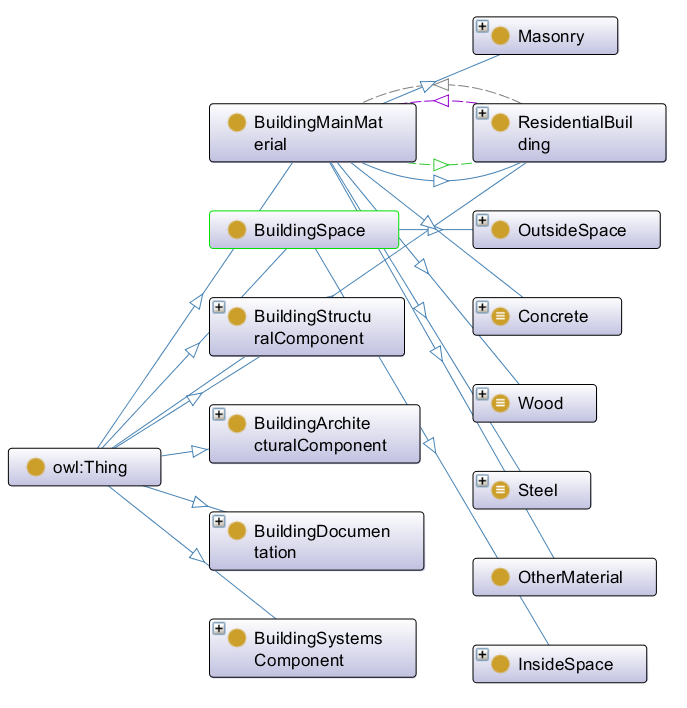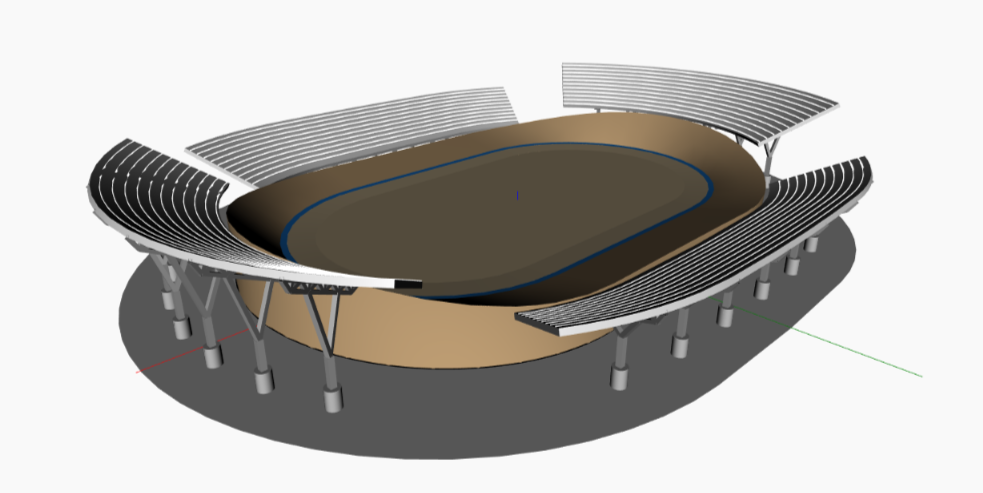Ontology
Figure 1. Ontology Model of Protege
Summary
The report explores the integration of ontology-based approaches in Building Information Modeling (BIM) to enhance the efficiency and accuracy of managing residential construction projects. Given the increasing complexity of construction projects, particularly residential buildings, there is a growing need for better integration of various subsystems such as HVAC, water supply, and electrical networks. The study focuses on developing an ontology prototype to systematically manage and navigate the key components of a building, reducing human errors and improving construction efficiency.
Following a top-down development approach, the study ensures a well-structured hierarchy that facilitates efficient data management, and also incorporates best practices in ontology development, including defining clear use cases, reusing existing ontologies, and maintaining a streamlined hierarchy to enhance usability. The ontology structure is categorized into seven major classes:
- Architectural Component
- Structural Component
- System Component
- Building Space
- Material
- Documentation
- Design Option
The report identifies key engineering challenges at various stages of the building lifecycle, including design coordination, subcontractor interface management during construction, and maintenance requirements during operation. It underscores the significance of integrating Building Information Modeling (BIM) with Project Management Information Systems (PMIS) to enhance stakeholder collaboration while acknowledging that the lack of standardized data exchange interfaces remains a significant hurdle.
To address these challenges, the study explores three primary applications of ontology:
- Construction Management, where BIM functions as a database for PMIS, streamlining project workflows and improving coordination
- Building Energy Management, which leverages sensor data to monitor and optimize energy consumption
- Building Renovation, where structured BIM models facilitate efficient renovation planning by providing accurate and accessible building information.
In conclusion, future research directions should focus on standardizing data exchange interfaces to enhance interoperability and expanding ontology applications to urban-scale modeling. These engineering reflections offer valuable insights that support the vision of sustainable development.
Clarity of the Chosen Domain
The study focuses on residential buildings and their integration with ontology-based BIM (Building Information Modeling) systems. Given the increasing complexity of modern construction projects, effective data organization, system decomposition, and performance evaluation are critical for enhancing construction efficiency and minimizing errors.
The ontology model is developed to organize and manage building elements, covering structural components, facilities, materials, and spatial arrangements. It acts as a framework for integrating project information across different phases of a building’s lifecycle.
Well-Defined Engineering Challenge
The research identifies several engineering challenges within the lifecycle of residential buildings:
- Product Stage – Coordination between architects, contractors, and material suppliers during design and tendering processes.
- Construction Stage – Issues arising from multiple trades working in the same location and integration challenges among subcontractors.
- Use Stage & End-of-Life Stage – Data collection and integration for maintenance, operation, and renovation planning.
The study aims to enhance the integration of BIM systems with other project management tools (PMIS, IoT, etc.), ensuring data consistency and usability across stakeholders.
Environmental Interfaces
The ontology interacts with various systems across different stages of a building’s lifecycle:
- Construction Phase – Interfaces with stakeholders (architects, project managers, contractors) through BIM and PMIS (Project Management Information Systems) for improved coordination and project tracking.
- Use Phase – Integration with building infrastructure (HVAC, electrical, and water supply systems), enabling data-driven energy management and efficiency analysis.
- Urban Scale Integration – Potential expansion to city-wide Urban Building Energy Modeling (UBEM), utilizing BIM-based simulations to optimize energy demand.
The study discusses BIM-PMIS integration challenges, including the lack of standardized data exchange between different systems.
Parametrization (Instantiation) of the Chosen System
The ontology is structured into two primary components:
- Building Elements – Physical (structural, material, facility), functional, and logical decomposition of the building system.
- Relevant Documents & Models – Includes 3D models, floor plans, sections, and other related information.
The system follows an ontology-based hierarchy, ensuring:
- Defined roles and attributes for different components.
- Integration with 3D modeling software for improved visualization.
- Limitation of class hierarchies to four levels to enhance usability.
The ontology is implemented using Protégé, incorporating axioms and restrictions for clear definition and validation of relationships.
Clarity of Engineering Examples
The study presents three key use cases:
- Construction Management
- Ontology enables BIM-PMIS integration, allowing real-time document updates, progress tracking, and risk mitigation.
- Enhances stakeholder collaboration by streamlining construction workflows.
- Building Energy Management
- Sensor data integration within the ontology enables real-time monitoring of energy consumption.
- Allows for performance optimization and predictive maintenance based on historical energy trends.
- Building Renovation
- Ontology facilitates tracking structural properties (e.g., steel aging, material deterioration) for informed renovation decisions.
- 3D-based BIM models provide simulation capabilities for different renovation strategies.
These examples demonstrate how ontology-driven BIM applications improve project efficiency, energy optimization, and renovation planning.
Conclusion & Future Research
The study concludes that ontology-based BIM systems significantly improve project integration, data management, and stakeholder collaboration. The research highlights:
- The potential of standardizing interfaces between BIM, PMIS, and energy management tools.
- The expansion of ontology applications beyond individual buildings to urban-scale energy modeling for sustainable city planning.
Full report:se-model_project1_chiachengtu_0508005
Parametric Model
Figure 2. Parametric Model in Dynamo
Summary
Building on a previous study that applied ontology-based modeling to residential buildings, this research adapts the same logical framework for velodrome design. While the original ontology focused on housing, its core structure remains relevant to sports facilities with modifications to functional space allocation. This approach provides a structured way to evaluate design variations using parametric modeling.
The research explores the application of parametric modeling in architectural engineering to analyze how building dimensions impact construction costs and carbon footprint performance. Using a velodrome with at least 5,000 seats in Hong Kong as a case study, the study examines the relationship between geometric input parameters and key performance metrics. Unlike conventional buildings, velodromes are structured around a central sports space, making them well-suited for parametric design approaches using tools like Dynamo. To explore design variations, the study focuses on key parameters such as the number of seating rows, stand locations, and building stories. Structural and spatial constraints remain fixed based on industry standards. Four design alternatives are evaluated, each with different story heights and seating configurations, to assess their impact on cost and carbon emissions.
Results show that adding more stories significantly reduces land costs—by about 23.1% per additional floor—while structural costs increase by approximately 9.55%. The location of stands has a much smaller impact, with cost differences around 3% and carbon footprint variations of about 6%. Among the four options, the four-story design (Alternative 4) proves to be the most cost-effective, even with slightly higher carbon emissions.
By systematically evaluating cost and sustainability trade-offs, this study demonstrates the advantages of parametric modeling in velodrome design. Future research should focus on standardizing the integration of environmental factors and real-world construction constraints to further improve parametric simulations.
Design Challenge
The primary design challenge in this study is to integrate the velodrome structure seamlessly with the racing track while optimizing both construction cost and carbon footprint. The racing track serves as the architectural core, and the challenge lies in designing a seating arrangement that meets spatial and functional requirements while maintaining efficiency. Additionally, constraints such as limited land availability and regulatory standards make the optimization process more complex.
High-Performance Criteria and Related Parameters
The study evaluates design alternatives based on two key high-performance criteria:
- Monetary Cost – Includes both construction costs (materials, structural components) and land acquisition costs.
- Carbon Footprint – Measured in terms of CO₂ emissions, considering materials used in construction.
Design parameters:
- Fixed Parameters (Building Standards)
- Beam and column dimensions
- Track specifications (perimeter, width, slope)
- Seating specifications (row height, passage width)
- Input Parameters (Variable Design Components)
- Number of stand stories (1 to 4)
- Number of rows of seats (8 to 21)
- Stand location (straight side only or both straight and curved side)
Parametric Model Logic
The parametric model is structured into three main components:
- Track Zone Construction – Using geometric curves and regulatory standards to define the track layout.
- Stands Configuration – Adjusting stand geometry based on seat dimensions, viewing angles, and spatial constraints.
- Structural Components – Defining and analyzing the required columns, beams, and trusses, ensuring stability while minimizing material usage.
The model is developed in Dynamo, allowing flexible adjustments to track and seating configurations while maintaining a systematic method for evaluating performance.
Design Space, Extremes, and Limits
The design space is shaped by:
- Regulatory constraints (e.g., track dimensions and audience sightlines)
- Land cost considerations (higher stories reduce land cost but increase structural costs)
- Sustainability trade-offs (higher structures may lead to increased material use and emissions)
Extremes within the design space include:
- Lowest cost and emissions – Smaller, single-story designs, but these are land-intensive and less spatially efficient.
- Highest cost and emissions – Multi-story alternatives that reduce land usage but require more structural materials.
Identified Good Alternatives
Among the four tested design alternatives, the best-performing solutions based on cost and emissions are:
- Alternative 4 – A four-story structure with seating on the 2nd, 3rd, and 4th floors.
- Lowest total cost (€122.86 million)
- Highest CO₂ emissions (1.50 million tons), but cost savings outweigh the increase in emissions.
- Alternative 3 – A three-story structure with stands on both the straight and curved sides.
- Balanced cost-performance (€140.84 million)
- Lower emissions than Alternative 4 (1.31 million tons)
- Alternative 2 – A three-story structure with stands only on the straight side.
- Comparable cost to Alternative 3 (€141.16 million)
- Slightly higher emissions than Alternative 3 (1.39 million tons)
Conclusion: Best Embodied Solutions
- Alternative 4 is the most cost-efficient and minimizes land use, making it the best overall choice despite higher emissions.
- Alternative 3 optimizes seating distribution while maintaining moderate costs and emissions.
- Alternative 2 offers a simpler design with a reasonable trade-off between cost and sustainability.
These alternatives represent well-embodied solutions by balancing spatial efficiency, financial feasibility, and environmental responsibility, making them ideal for real-world application.
Full report:se-model_project2_chiachengtu_0508005
Introduction|Individual Systems|Integration Context|Combined Ontology|Combined Parametric Model|Conclusion

